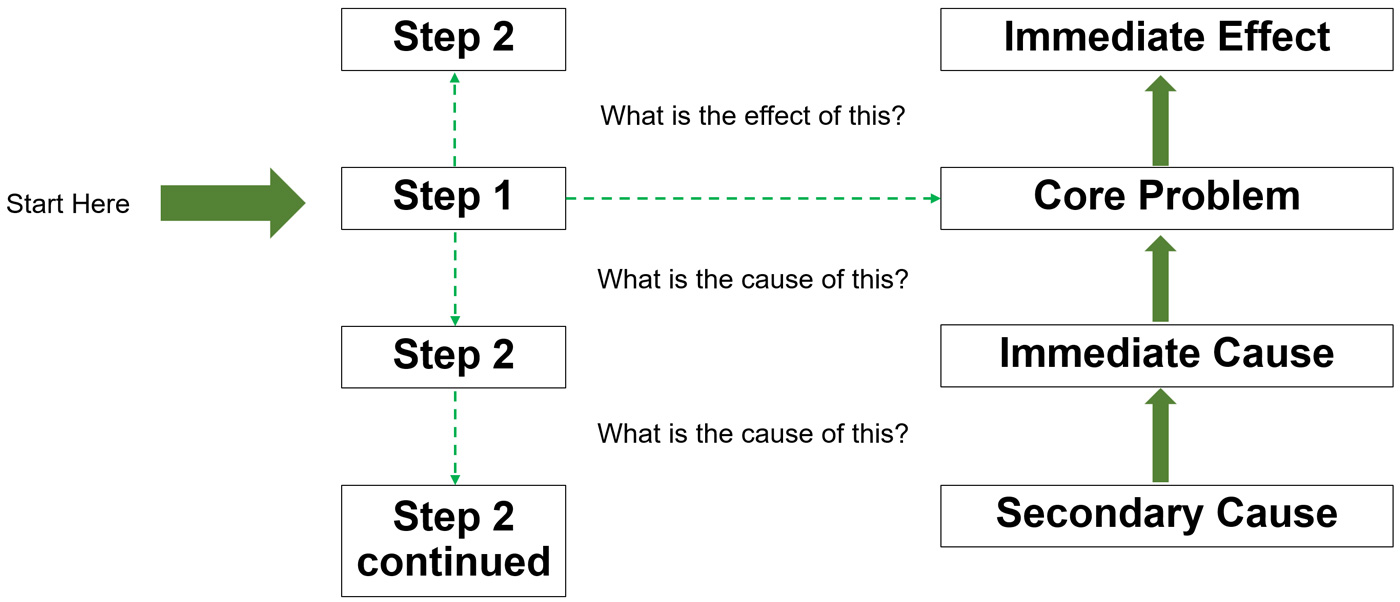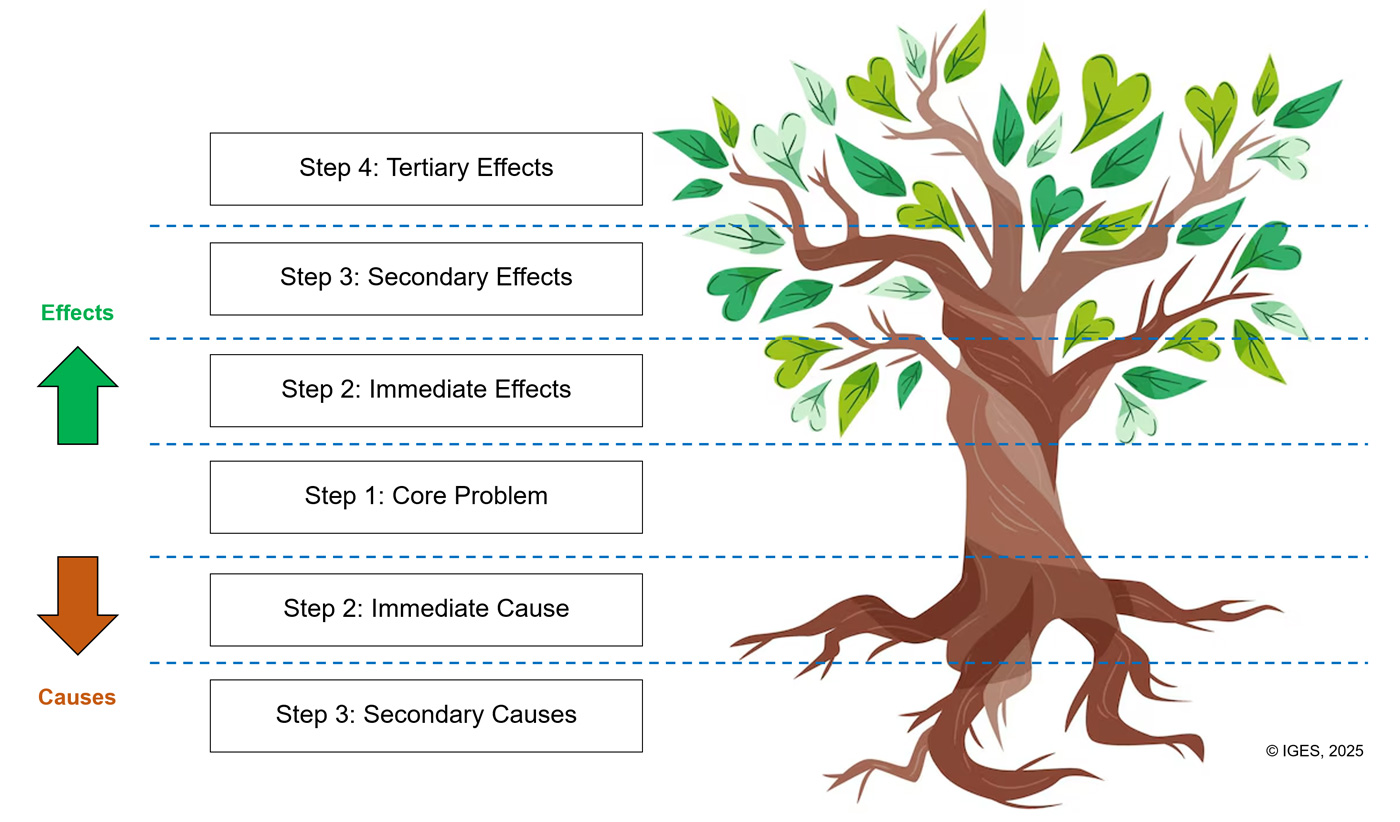The Problem Tree Analysis and Objective Tree Analysis are essential tools in Green Climate Fund Concept Note Project Planning because they provide a structured way to understand, define, and articulate the project’s context, logic and rational. These tools are a part of the Logical Framework Approach (LFA) and are particularly valuable in climate finance and development projects where clarity and alignment with funding criteria are crucial.
The use of Problem Tree and Objective Tree methods clarifies complex issues by showing interconnections between problems, helps prioritize interventions by targeting root causes, builds consensus among stakeholders on the nature of the problem, lays the groundwork for the Theory of Change (ToC). The use of Problem Tree and Objective Tree creates a solid foundation for drafting a high-quality GCF Concept Note that meets GCF’s rigorous requirements for clarity, impact and strategic fit.
| Tool | Main Role | Relevance to GCF Concept Note |
|---|---|---|
| Problem Tree | Diagnoses the core problem and its causes/effects. | Ensures the project is grounded in a real climate relevant issue linked to sectoral pathways1 contributing to NDCs and GCF Strategic Plan 2024 – 20272. |
| Objective Tree | Converts problems into objectives and solutions. | Helps define the Theory of Change (ToC) and build a logical fundable climate project that contributes to NDCs and GCF Strategic Plan 2024 – 2027. |
Problem Tree Analysis
The Problem Tree is a visual tool that helps identify and analyze the core problem the project aims to address along with its causes and effects. Problem Tree Analysis contributes to project planning in the following ways:
- Clarifies the root problem: The tool helps stakeholders and project developers understand the central climate related issue that the project will address.
- Identifies cause-effect relationships: The tool helps breaking down the problem into direct and indirect causes and their effects, enabling more targeted and effective interventions.
- Informs the project logic: The tool helps to provide a foundation for defining the theory of change and ensuring the project has a clear logical structure linked to the GCF’s sectoral paradigm shifting pathways, that will contribute to Nationally Determined Contributions (NDCs).
- Aligns with GCF investment criteria: GCF prioritizes projects that clearly addresses climate vulnerabilities and emission reduction. A well-developed problem tree supports the alignment of ground based realities with GCF Strategic Plan 2024 – 2027.
Getting Started and Project Idea Validation
As a project proponent, you are faced with multiple problems. In urban areas, for example, the local population might complain about issues such as:
- (i)drainage and flash floods
- (ii)traffic congestion
- (iii)water supplies
- (iv)air pollution
- (v)noise
- (vi)solid waste disposal
- (vii)education facilities etc.
How do you identify which problem(s) among all of these may be suitable for GCF funding?
Validation of project idea – source and eligibility are important. The project idea that some project proponents choose may not even be suitable for GCF funding nor sourced from an official government climate plan.
Therefore, it is of paramount importance to align the problem tree early, with the GCF sectoral paradigm shifting pathways and identify the contributions that the project can make towards the submitted Nationally Determined Contributions (NDCs) and to the GCF Strategic Plan 2024 – 2027.
Problem Tree Analysis Method
The Problem Tree method involves creating a diagram that looks like a tree. The trunk represents the core problem (the main issue to be addressed). The roots represent the causes (factors contributing to the problem). The branches represent the effects (consequences or results of the problem). Upon validation of Project Idea, it is important to start by defining the problems to be solved using a problem tree analysis. The figure below is providing an illustration on how to start analyzing the problem tree. One way to start the problem tree method is to identify which aspects of the problem may be related to climate change and therefore suitable for climate finance to address under the GCF funding categories.

Project preparation is always best done as a team effort. Brainstorming on the main problems facing your project area (which can be a city, district, province or a watershed). No problem should be rejected. List them all on a sheet. Then debate on the following key elements:
- Which of these problems are directly caused by climate change.
- Which of the problems have the greatest impact on the area’s population, livelihood and economy.
- The alignment between the identified problems and the GCF’s sectoral paradigm shift pathways3.
- How these problems could contribute to Nationally Determined Contributions (NDCs);
- How these problems could contribute to the GCF Strategic Plan 2024 – 20274.
Problem Tree Analysis Format
In order to continue narrowing down the core problem, while debating the key elements in respect to the identified problem, the problems should be analyzed further to identify the core problem. To identify the core problem, clearly define the main issue affecting the target group or environment can help the analysis. List the causes and brainstorm what is causing the core problem and continue with arranging them hierarchically (direct and indirect causes). Then proceed with listing the effects to identify the impacts resulting from the core problem. With all core problems, effects, and causes identified, structure the tree by placing the core problem in the center, causes below it, and effects above it. It is better to do this in a discussion format so that the problems, causes, and effects can be validated with stakeholders to ensure that the problem and its relationships are accurate and agreed upon.

The figure above provided an illustration of the analysis described above. In short, elements of the problem tree analysis can be described as below:
Core problem
- The central issue you want to address.
- Should be specific, relevant, and within the scope of the project.
Causes (roots)
- Direct and indirect reasons why the core problem exists.
- These can include institutional, social, environmental, or economic factors.
Effects (branches)
- The results or consequences that arise from the core problem.
- These show how the problem affects people, the environment, or the economy.
Objective Tree Analysis
Linking the Problem Tree with the Objective Tree is a key step in project planning, especially where demonstrating a clear logic and rationale is essential such as in frameworks like the GCF Concept Note. The Objective Tree directly derives from the Problem Tree (Figure 5.2) and represents a positive mirror image of it. The Objective Tree is built by reversing the problems in the Problem Tree into positive, achievable objectives (solutions or desired outcomes). It shows how desired outcomes can be achieved through specific outputs and activities.
Briefly, the transformation process from Problem Tree to Objective Tree can be simplified as below:

Employing the Objective Tree Analysis can contributes to project planning in the following ways:
- Establishes a clear theory of change. The tool demonstrates how project interventions (activities and outputs) lead to outcomes and impact which is crucial in the GCF Concept Note.
- Supports logical framework development. The tool helps in forming the basis of the log frame including indicators assumptions and means of verifications.
- Facilitates strategic planning: The tool ensures that each component of the project contributes to solving the root problem.
- Enhance stakeholder engagement. The tool provides a clear visual roadmap that can be easily communicated to partners, beneficiaries and funders.
- Strengthens funding justification. The tool shows how the project contributes to GCF’s sectoral paradigm shifting pathways5 contributing to Nationally Determined Contributions (NDCs) whilst also aligning with GCF Strategic Plan 2024 – 20276.
Objective Tree Analysis Method
To do the objective tree analysis, it starts with the Problem Tree. Confirm and agree on the core problem, its causes, and effects. Flip the Statements. Turn each problem statement into a goal-oriented objective. For example:
- “Poor water availability” becomes “Improved water availability”.
- “Lack of climate-resilient seeds” becomes “Access to climate-resilient seeds improved”
Use the goal-oriented objective to reconstruct the Tree Structure. Keep the structure (causes at the bottom, effects at the top), but now state how the objectives logically lead from one to the next.
Define the Project Logic. The root causes become inputs and activities. The core problem becomes the main objective or outcome. The effects become longer-term impacts. Use these combinations to Develop the Theory of Change. The Objective Tree should support in writing the Theory of Change. The result of objective tree analysis can show how the inputs lead to outputs, outcomes, and impacts over time.
- 1GCF. (2022). Sectoral Guides Summaries. Sectoral Guide Series. Yeonsu: Green Climate Fund.
- 2GCF. (2023). Strategic Plan for the Green Climate Fund 2024 – 2027. Decisions of the Board – thirty sixth meeting of the board, 10 – 13 July 2023. Yeonsu: Green Climate Fund.
- 3GCF. (2022). Sectoral Guides Summaries. Sectoral Guide Series. Yeonsu: Green Climate Fund.
- 4GCF. (2023). Strategic Plan for the Green Climate Fund 2024 – 2027. Decisions of the Board – thirty sixth meeting of the board, 10 – 13 July 2023. Yeonsu: Green Climate Fund.
- 5GCF. (2022). Sectoral Guides Summaries. Sectoral Guide Series. Yeonsu: Green Climate Fund.
- 6GCF. (2023). Strategic Plan for the Green Climate Fund 2024 – 2027. Decisions of the Board – thirty sixth meeting of the board, 10 – 13 July 2023. Yeonsu: Green Climate Fund.

